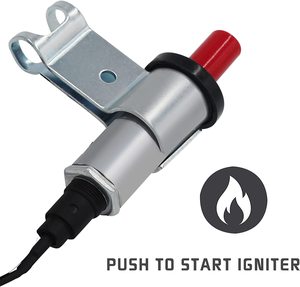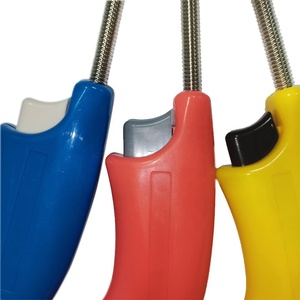(124 products available)














































































































































A piezo spark ignitor, also known as a piezoelectric ignition system, is a device used to produce a spark for igniting fuel in various applications like barbecues, gas stoves, lighters, or candles. It works through the piezoelectric effect, which generates an electric charge or voltage in certain materials when mechanically stressed. In this case, squeezing a button compresses a piezoelectric crystal, creating a high-voltage spark. This spark ignites the fuel. Piezo spark ignitors are handy because they work without batteries or electricity, relying solely on mechanical energy. They are commonly used in outdoor grills, camping gear, and emergency lighters, providing a reliable and efficient way to start a flame when cooking or heating food in outdoor settings or emergency situations.
Piezoelectric ignitors are mechanical devices made of durable materials such as stainless steel, ceramics, or high-impact plastics. They are designed to withstand the rigors of outdoor use, including exposure to moisture, dirt, and varying temperatures. This durability ensures that the ignitor can consistently perform well over time, even in challenging environmental conditions, making it a reliable choice for outdoor cooking and other applications where resilience is essential.
Different types of piezoelectric ignitors are available, each designed for specific applications and preferences. These ignitors ensure that the spark needed to ignite fuels can be produced efficiently and reliably in various settings. They have found applications in many fields, providing a reliable and convenient way to generate ignition for fuels. Different types of piezo spark ignitors are available, each designed for specific applications and preferences.
Portable ignitors
These small ignitors are designed for use in portable devices like handheld lighters and camping stoves. They use mini piezoelectric crystals to create sparks for ignition.
Tabletop ignitors
Tabletop ignitors are used in devices like gas grills and fire pits. They have larger components that create bigger sparks to ignite larger flames.
Integrated ignitors
Integrated ignitors are built directly into cooking appliances like gas stoves and ovens. They are connected to the appliance's gas supply and automatically generate a spark when the burner knob is pressed.
Modular ignitors
Modular ignitors are separate units that can be installed on various appliances. They come in different sizes and designs, allowing for compatibility with multiple devices.
Universal ignitors
Universal ignitors can be used across different devices and applications. They are compatible with various fuels, including propane, butane, and natural gas.
Custom ignitors
Custom ignitors are designed to meet specific application requirements. They can be tailored in size, shape, and performance to fit specialized needs.
Material
Although there are many materials to choose from, the materials used in the igniter are usually ceramic glass and metals. The materials have high strength and hardness, wear resistance, corrosion resistance, and high-temperature resistance. These properties can meet the needs of industrial applications. In addition, the selected materials also have good performance in electrical properties, which is conducive to enhancing the ignition efficiency and reliability of the igniter.
Size and shape
The size and shape of the igniter are designed to meet the requirements of specific applications. For example, the igniter used in gas stoves is relatively small and compact to facilitate installation and use. On the contrary, the igniter used in industrial boilers needs to have a larger volume and more complex structure to adapt to the requirements of high power and high pressure. The size and shape of the igniter are also affected by factors such as installation and usage environment. Therefore, the design of the igniter should consider the size and shape of the aspects to ensure that it can be installed and used conveniently and reliably.
Appearance design
The appearance design of the igniter usually considers the following aspects: first, the aesthetics of the igniter can enhance the attractiveness and competitiveness of the product; second, the ease of use and convenience of the igniter can improve the operational efficiency and user experience; third, the safety performance of the igniter must be ensured to prevent accidental ignition or electric shock. For example, the igniter used in outdoor gas appliances needs to be waterproof and anti-damp to ensure that it can work reliably in various weather conditions; the igniter used in automobile engines requires anti-vibration and shockproof design to ensure that it works stably in the process of driving.
Ignitor for stoves
A piezoelectric igniter is extensively used in gas stoves and burners. It is used to ignite the gas to start cooking. The small size and efficiency of the igniter make it very useful for stoves. The igniter produces a spark that ignites the gas, enabling the burner to create a flame for cooking.
Ignitor for barbecue grills
In barbecue grills, a piezoelectric igniter is used to ignite the gas or propane fuel. Once the ignition button is pressed, the crystal inside produces an electric spark that ignites the fuel to create a flame for cooking barbecue.
Fireplace ignitor
In gas fireplaces, a piezoelectric igniter is used to ignite the gas. The igniter produces a spark that ignites the gas, creating a warm and cozy fire for heating and ambiance.
Ignitor for lanterns
In gas lanterns, the igniter is used to light the gas. The small and efficient igniter produces a spark that ignites the gas, providing light for outdoor activities.
Ignitor for outdoor heaters
In gas patio heaters, the igniter lights the gas. The igniter is essential for starting the flame in the heater, enabling it to warm up the outdoor space.
Ignitor for camping stove
In portable gas camping stoves, a piezoelectric igniter is used to light the gas. The igniter is compact and does not require batteries or electricity, making it perfect for camping.
Gas turbine engines
In small gas turbine engines, piezoelectric igniters are used to initiate combustion in the combustion chamber. The igniter spark initiates the rapid combustion process that powers the engine.
Internal combustion engines
A piezoelectric igniter can be used in the starting system of small internal combustion engines, such as chainsaws, lawnmowers, and outboard motors. The igniter helps initiate combustion in the engine to produce mechanical power.
Wholesale buyers should consider these factors when choosing a piezo spark ignitor.
Product Specifications
Understand the product specifications and features. Ignitors have different materials, sizes, and spark energies. Determine which ones fit the needs of the customers. Also, check if there are any certifications or standards that the ignitors need to meet.
Manufacturer Reputation
Choose manufacturers with a proven track record of producing quality ignitors. Investigate how long the manufacturers have been in the business. Also, check their reviews and ratings from other customers. Select manufacturers with strong customer support. They should be able to respond to inquiries and resolve issues quickly.
Cost and Pricing
Consider the cost of the piezo spark ignitors. Ensure that the price fits the budget and allows for a reasonable profit margin for resale. Negotiate with the suppliers to reduce the cost of bulk orders. Ask for discounts or incentives for large purchases.
Compatibility with Existing Products
Ensure that the ignitor is compatible with the products that will be sold end users. Consider the features and specifications of the products that ignitors are used in. Choose ignitors that work well with the popular products in the market.
Availability and Lead Time
Check the availability of the piezo spark ignitors and the lead time for orders. Choose suppliers who can quickly supply ignitors. They are ideal for meeting urgent customer demands. But, also consider ordering well in advance to avoid stockouts.
Market Trends and Customer Demand
Research market trends to know the ignitor features that are becoming popular. Find out what customers demand and choose ignitors that will satisfy their needs. Consider the types of ignitors that could become obsolete and avoid them.
Regulatory and Safety Compliance
Ensure that the piezo spark ignitors comply with relevant regulations and safety standards. Understand the compliance requirements in the target market and ensure that the ignitors meet them. This reduces the risk of product recalls and legal issues.
Q1: How does a piezoelectric igniter work?
A1: It generates a spark to ignite fuel by mechanically stressing a piezoelectric material.
Q2: What are the applications of piezo spark ignitors?
A2: They are used in lighters, grills, boilers, and gas burners, among other applications requiring ignition.
Q3: What are the advantages of piezoelectric ignitors?
A3: They offer benefits like being self-contained, having no battery or electricity needed, and being reliable and durable.
Q4: How is a piezo spark ignitor different from regular batteries?
A4: It produces sparks through mechanical force instead of using batteries to create a chemical reaction.
Q5: Why are ignitors with piezoelectricity preferred?
A5: They are preferred for their simplicity, reliability, and ability to work in various environmental conditions.